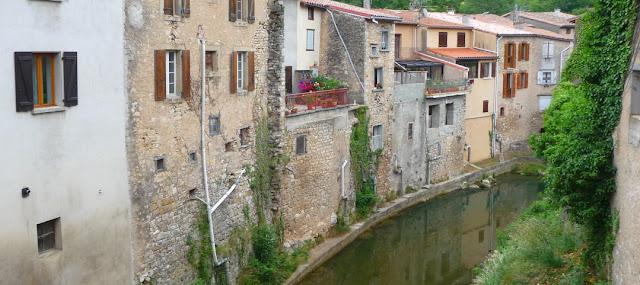An
apricot sun leaked into the pale sky, where swallows swirled in crazy
patterns way above the village. A cock crowed. A tractor rumbled
along the Rue de Village. The air was still.
We
ate warm stewed apricots, bought in a nearby village market, and
marvelled at a taste we remembered from childhood.
In
such a peaceful place it is difficult to imagine the tragic events of
the 12th and 13th centuries in this region.
We are staying in the Aude region of the south of France,
Cathar country. I want to learn more about the story of the
Albigensian Crusade by following the Cathar
trail past crumbling castles on craggy mountain tops.
After
breakfast, we decided to go to the last stronghold of the Cathars,
the remote Montsegur Chateau in the Pyrenees, rumoured to protect the
Holy Grail.
 |
| Puivert... en route to Montsegur |
 |
| Chateau at Puivert, former home of Cathar troubadour-poets and musicians. |
Esclarmonde,
a mother of six, was widowed when she was sixty, and became what
was effectively a high priestess of the Cathars, with the full
support of her brother, the Count of Foix.
 |
| Castle ruins at Quillan on the River Aude. |
Catharism
spread like wildfire in the 12th and 13th
centuries as a reaction against the corruption, elitism and power of
the Catholic Church. Cathars thought that the 'catholic wolves',
had distorted Christ's messages about how to live. The only prayer of
the Cathars was the 'Lord's prayer' and their only sacrament
was the 'consolatum', the laying on of hands.
Unlike
the Catholics, they believed in the equality of women, which is why
Esclarmonde played such an important role. Cathars valued work and
austerity. Esclarmonde sold all her wordly goods and gave away her
castle. She established schools for girls and hospitals [remember
this is back in the 12th century], and initiated the
rebuilding of Montsegur Castle as a Cathar stronghold against the
relentless campaigns by the Catholic hierarchy and the French
monarchy which continued for
well over 100 years until the Cathars were eliminated or driven into
secrecy.
 |
| Queribus castle... its view... its state... its descent. |
It was in 1207 at the conference between the opposing Cathars and Catholics at Pamiers Castle that Esclarmonde spoke on behalf of the Cathars. One of the Brothers cried, “Really Madam, spin on your distaff, it ill becomes you to participate in such discussions.”
And
how many centuries later was I sticking the feminist slogan of the
seventies, 'Woman's place is everywhere!' on my car bumper?
Esclarmonde's
story has merged with the myths surrounding her illegitimate niece
and namesake, who died on the pyre at Montsegur, when after a ten
month siege, during the harshest of winters, the Cathars were
overcome and given the choice of conversion or being burnt at the
stake. More than two hundred chose the martyrdom and were burnt alive
at Montsegur.
 |
| Montsegur castle where more than 200 Cathars were burned alive in 1243. |
As
I struggled up the steep stony path to Montsegur, I thought,
“Esclarmonde was here.” She walked this path nine centuries ago,
first as noblewoman then as a 'good Christian', the name for
the leaders of the Cathars.
What
was she like? Slim and wiry with tiny feet and aristocratic pale
skin? Legs as agile as those of a mountain goat? Or was she stocky
and round with staunch muscular legs? Did she wear the pilgrim's
hooded cloak and walk with a staff or did she ride on horseback?
Was
I hoping to feel her presence on this mountain top? Yes I was!
In
a way, I am travelling here as a pilgrim, hoping to find in a
particular place or through a journey, some insight, the way that
pilgrims of every religion have done.
 |
| A pilgrim's progress. |
On
the flight from Australia, I watched a film to pass the time. It was
'The Way' a contemporary American film about a man whose son
dies in France as he begins the 'Camino de Santiago', an
increasingly popular pilgrims'
walk across the Pyrenees. The father, a golf playing
conservative, middle class guy, doesn't understand his son's
itinerant lifestyle. But he decides to do the walk, carrying his
son's ashes, and of course he not only 'finds' his son but
rediscovers himself. Wasn't it Jesus who said,
“I am the Way.”?
Once
a pilgrimage meant travelling to visit relics, like bits of the
cross, or threads from Jesus's robe or the bones of dead saints, or
places where miracles have happened or other important religious
sites. [Lourdes is the second most visited place in France, and
Carcassonne, a Cathar castle, is the third].
 |
| Mirepoix, Ariege... site of yet another massacre of Cathares by the Catholic Crusaders. |
Perhaps
it is the journey that matters. Not the destination.
 |
| Buildings in early days did not not have 'insulation ratings' but the Montsegur Castle would surely score highly. |


No comments:
Post a Comment